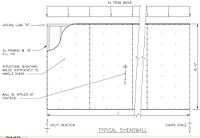
Photo from wikipedia
Abstract This paper develops a model to forecast unreinforced masonry buildings’ usability, i.e. the condition of a building being habitable or occupiable after a seismic event. The model is based… Click to show full abstract
Abstract This paper develops a model to forecast unreinforced masonry buildings’ usability, i.e. the condition of a building being habitable or occupiable after a seismic event. The model is based on scores given to seven building parameters that are usually easy to survey: building position within the structural aggregate, number of storeys above ground, construction timespan, structural class, presence of strengthening interventions, roof type, and pre-existing damage to structural elements. Usability coefficients are calibrated for each category of each parameter, by varying macroseismic intensity and regressing data from the 2009 L’Aquila earthquake in central Italy. The parameters contribute to the creation of a synthetic index, according to weights or loading computed through principal component analysis. Usability probability matrices are determined and they can be used for territorial scale scenario assessment, as shown with an application to an entire historical centre.
Journal Title: Soil Dynamics and Earthquake Engineering
Year Published: 2017
Link to full text (if available)
Share on Social Media: Sign Up to like & get
recommendations!